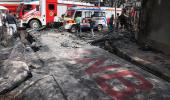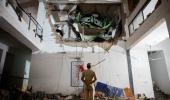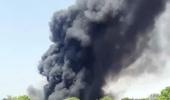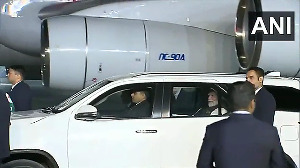How cockpit voices and flight data unravel what happened during an air crash.

When an aircraft crashes, the most urgent questions arise almost instantly: Was it a mechanical failure? Did the pilots make an error? Or was something else at play?
The first place investigators look for answers is the aircraft's black boxes -- the Cockpit Voice Recorder (CVR) and the Digital Flight Data Recorder (DFDR), or, just Flight Data Recorder (FDR).
These rugged devices hold the keys to decoding disaster, capturing the final conversations in the cockpit and tracking every change in the aircraft's flight path.
In this interview with Prasanna D Zore/Rediff, Group Captain Rajiv Kumar Narang (retd), an experienced air crash investigator and author of India's Quest for UAVs and Challenges, breaks down how these devices work and what information they record.
From distinguishing between internal and external cockpit conversations to understanding whether any video is captured, Group Captain Narang lays out the fundamentals of black box operations.
What exactly is a cockpit voice recorder (CVR), and what kind of information does it capture?

The cockpit voice recorder records all communication that happens in the cockpit. This includes two types of communication: External (radio or telephone with air traffic control) and internal (between crew members).
These conversations are critical during emergencies or crashes, helping investigators understand what the crew was experiencing and how they responded.
Does the CVR also record video from the cockpit?
No, the CVR captures only audio. Video is not currently mandated, mainly because it would produce excessive and often unnecessary data. Audio alone provides significant insights into what occurred.
Specifically, the CVR captures:
• Pilot and co-pilot conversations
• Radio transmissions with air traffic control
• Sounds within the cockpit, such as alarms, switches, engine noise, and other ambient audio
The idea is to document the crew's communication, decision-making, and situational awareness during flight, especially in the final moments leading up to an incident.
What is a flight data recorder (FDR), and how is it different from the CVR?
The FDR logs technical flight data -- such as altitude, speed, engine power settings, heading, and control inputs -- enabling investigators to assess how the aircraft was performing and whether it was being flown within prescribed safety parameters.
In contrast, the CVR captures cockpit sounds and voices.
Can the FDR provide insights into engine failure, bird strikes, or fuel levels?
Yes, indirectly. Engine parameters captured by the FDR can show sudden anomalies, like power drops during a bird strike or technical failure. While the recorder may not log precise fuel volumes, related data allows experts to infer such details.
NEXT: How Investigators Recover, Decode Black Boxes











